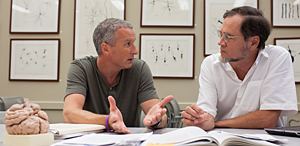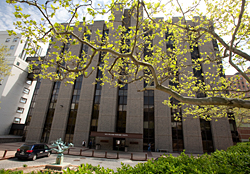

Tale of Two Colleagues
A Tale of Two Colleagues: Working to Improve the Lives of Children
The announcement last fall of $5.7-million dollars in NIH funding for the Rose F. Kennedy Intellectual and Developmental Disabilities Research Center (IDDRC) was big news for Einstein. The five-year initiative, which is creating an interdisciplinary collaboration involving numerous academic departments, is aimed at discovering basic brain mechanisms underlying intellectual and developmental disabilities as well as leveraging the most recent advances and technologies for improving diagnosis and for preventing and treating these diseases in children.

Steven Walkley, D.V.M., Ph.D., and John Foxe, Ph.D.And, none of it would have been possible without a family of cats.
For center director Dr. Steven Walkley and associate director Dr. John Foxe, a combination of serendipitous events, the essence of soul and Einstein's unique ethos have produced a creative, collaborative partnership that is bringing hope to children and families and enhancing the future of translational medicine at Einstein.
Dr. Walkley's first love was research. He graduated with a doctorate in veterinary medicine to prepare for working with animal models, and then did graduate studies at the medical school at the University of Alabama in Birmingham (UAB) under Dr. Henry Baker, who was conducting ground-breaking research toward the discovery and study of animal models of human disease.
When Dr. Baker discovered a family of cats in the 1970s that was the animal analog of Tay-Sachs disease, he began collaborating with Einstein's Dr. Dominick P. Purpura, who had just made the remarkable discovery of ectopic dendrite growth in kids with Tay-Sachs. As part of that collaboration, Dr. Walkley headed north to the Bronx.
Opportunity Knocks in the Bronx
"I came to stay for perhaps one year, to further my training in neuroscience," Dr. Walkley recalled. "It was 1978 and Dr. Purpura found me housing in the Mazer dorms. There was a big snowstorm that winter and I remember lying in the cramped dorm room thinking, ‘What on earth have I done?'"
Upon Dr. Walkley's arrival, Dr. Purpura walked him through the Kennedy Center floor by floor and showed him the work that was going on. "The building was an incredible center of neuroscience, which at the time was a nascent discipline," recalled Dr. Walkley. "It housed not only outstanding neuroscientists but also the finest neuropathology group in the world, who conducted translational research before the term ‘translational research' was minted. There were clinical researchers, basic scientists and physicians all working together to solve problems side by side."
One year led to another and Dr. Walkley completed his doctoral studies without returning to UAB. Much to his surprise and delight, Dr. Purpura invited Dr. Walkley to join the faculty. "The truth is, I had fallen in love with the place," he said.

Dr. Foxe and Dr. Walkley discuss work of the IDDRC. Behind them are drawings by Dr. Walkley's mentor, Dr. Dominick P. Purpura, including illustrations of the animal analog for Tay-Sachs disease stemming from the family of cats that brought Dr. Walkley to Einstein.Even so, his induction into Einstein was not without its difficulties. Despite his invitation, Dr. Purpura announced not long afterward that he was leaving Einstein for Stanford to serve as dean. "For me, it was sink-or-swim time," said Dr. Walkley. "I had no funding and my mentor was leaving."
He continued, "Dom's departure was actually really good for me. It made me realize you survive here on your own intelligence and creativity."
Dr. Purpura's departure also created new opportunity. "Dom had always run the medical school's neuroscience course, since part of our department's mission was to teach this ‘new' science to Einstein medical and graduate students," said Dr. Walkley. "When he left, the new chair, Dr. Michael Bennett, asked me to help with the course."
Although he had never planned on being a teacher, he was determined to sustain Dr. Purpura's legacy. In doing so, a funny thing happened. "I got on the stage in front of 180 medical students and I loved it. It was like being on Broadway."
Class Acts Crossing Paths
Over the ensuing years Dr. Walkley not only gained NIH funding for his own work on Tay-Sachs and related lysosomal diseases, but also became deeply involved as a lecturer and educational leader, eventually chairing the committee that re-vamped the entire medical school neuroscience curriculum in 1995.
And, it was in that classroom setting that John Foxe first met Steve Walkley — as a student, albeit an unlikely one.
Originally from Ireland with a degree in English and history, Dr. Foxe came to the United States on a track and field scholarship to Iona College, taking "bits and bobs of courses" to maintain his NCAA eligibility. An Iona professor, Dr. Tom Smith, who was a rabid track fan and taught a course in physiological psychology, kept pushing him to take his class.
"He said, ‘I promise you, it will blow your mind,' that was the phrase he used." So in the last semester of his senior year at Iona, Dr. Foxe took the course.
"And he was right. It did blow my mind. I decided right then, when I was finished with my running career, I would look for a career in the field."
Once his running career was winding down, he went back to that Iona professor and said, "Okay, I'm ready, what do I do now?"
"He told me that with absolutely no science background to speak of, my best bet was to get a job as a research technician in a good lab," said Dr. Foxe. Einstein was just a short distance from Iona, so he jumped the bus from New Rochelle to campus and literally started knocking on doors.
"I got my break with Dr. Dave Stapells, who took a chance on me. He was doing research making brainstem response recordings in premature babies, and I was hooked immediately. And after I published my first paper with Dave, there was no looking back," said Dr. Foxe.
He took courses at The City University of New York (CUNY) to burnish his science background, and applied to Einstein for grad school. Admitted provisionally, he could only attend if he completed a raft of undergraduate science courses before classes started in the fall.
In just 10 weeks of summer session at Iona, he completed them all. Which is how he came to be sitting in Dr. Walkley's neuroscience course.
"Steve was out-and-out my favorite professor," said Dr. Foxe. "He was a really inspirational figure for me. He was so cogent, and he focused on basic science with a translational mission. He just seemed like such a cool guy."
Ultimately, although their day-to-day focus as professionals differed – "I was a bench scientist, John worked directly with kids," said Dr. Walkley – their relationship continued.
"After I graduated, Steve recruited me to teach in the medical school neuroscience course," said Dr. Foxe. "And I did that for 12 years, even when I was away from Einstein." Prior to returning to the College of Medicine, he worked for seven years at the CUNY's City College, where he directed the Ph.D. program in cognitive neuroscience and co-directed its children's research unit. He also directed the Cognitive Neurophysiology Laboratory at the Nathan S. Kline Institute for Psychiatric Research, in Orangeburg, New York.
Serendipity Abounds
It was pure serendipity that Dr. Foxe ended up back at Einstein. "I came here to give grand rounds," he recalled. Einstein's Children's Evaluation & Research Center (CERC) director Dr. Robert Marion was at those grand rounds.

The Kennedy Center, home to Einstein's IDDRC"Einstein was actively recruiting a new research director for CERC and Bob thought I would be right for the job," explained Dr. Foxe. "At the time, I was actually 24 hours away from signing with Stony Brook. I decided to come home to Einstein instead."
And, with his return came a new partnership with his former professor. He recalled, "When I was a grad student, the Kennedy Center had a grant from NICHD [Eunice Kennedy Shriver National Institute for Child Health and Human Development, part of the National Institutes of Health]. It appeared to me to be the glue that held the place together." Indeed, the Rose F. Kennedy Center was one of NICHD's flagship mental retardation centers, as they were called in those days. Funded in the mid-1960s, funding was continuous until 2005.
Dr. Walkley added, "When we lost the Kennedy grant seven years ago, some of us were deeply affected by the loss. When John came back, he remembered it. It had influenced his career development just like it had mine. In informal chats begun in 2009 we decided we must do all we could to help get it refunded."
When Einstein's dean, Dr. Allen M. Spiegel, asked Drs. Walkley and Foxe to look at the feasibility of restoring the grant funding, "We became a two-man task force, and spent six months putting that grant together. And we got the money on the first try. It was pretty spectacular," said Dr. Foxe.
A Shared Passion
"John and I are both products of the Kennedy Center," said Dr. Walkley. "I came here undeveloped, at the beginning of my career. The Kennedy Center molded my thinking, and it has influenced how I do my research and why. John is also a product of this place. That's where our energy and drive came from with that grant. It was a labor of love through which we tapped into the center's rich history and passion. We wanted to re-create that environment in an innovative way."
The duo have been working together for two years now, bringing the CERC clinics back into the research program and encouraging basic scientists to investigate the disorders of these patients. "It's quite something to be in a working partnership with your favorite professor," said Dr. Foxe. "I admire his work, his passion, his ethics."
He continued, "I don't know how many other institutions would give an Irish guy with a degree in English a shot at this. Einstein is a special place. You come because of what is happening and the work that is going on. You become a part of it for philosophical reasons."
"I think Einstein has a soul," added Dr. Walkley. "I've always thought it. The people here who influenced me set the tone. They showed me what an Einstein faculty member should be. It is not just a medical school, it is a way of life."
And, it all started with a family of cats.
Posted on: Wednesday, August 29, 2012

Tablet Blog